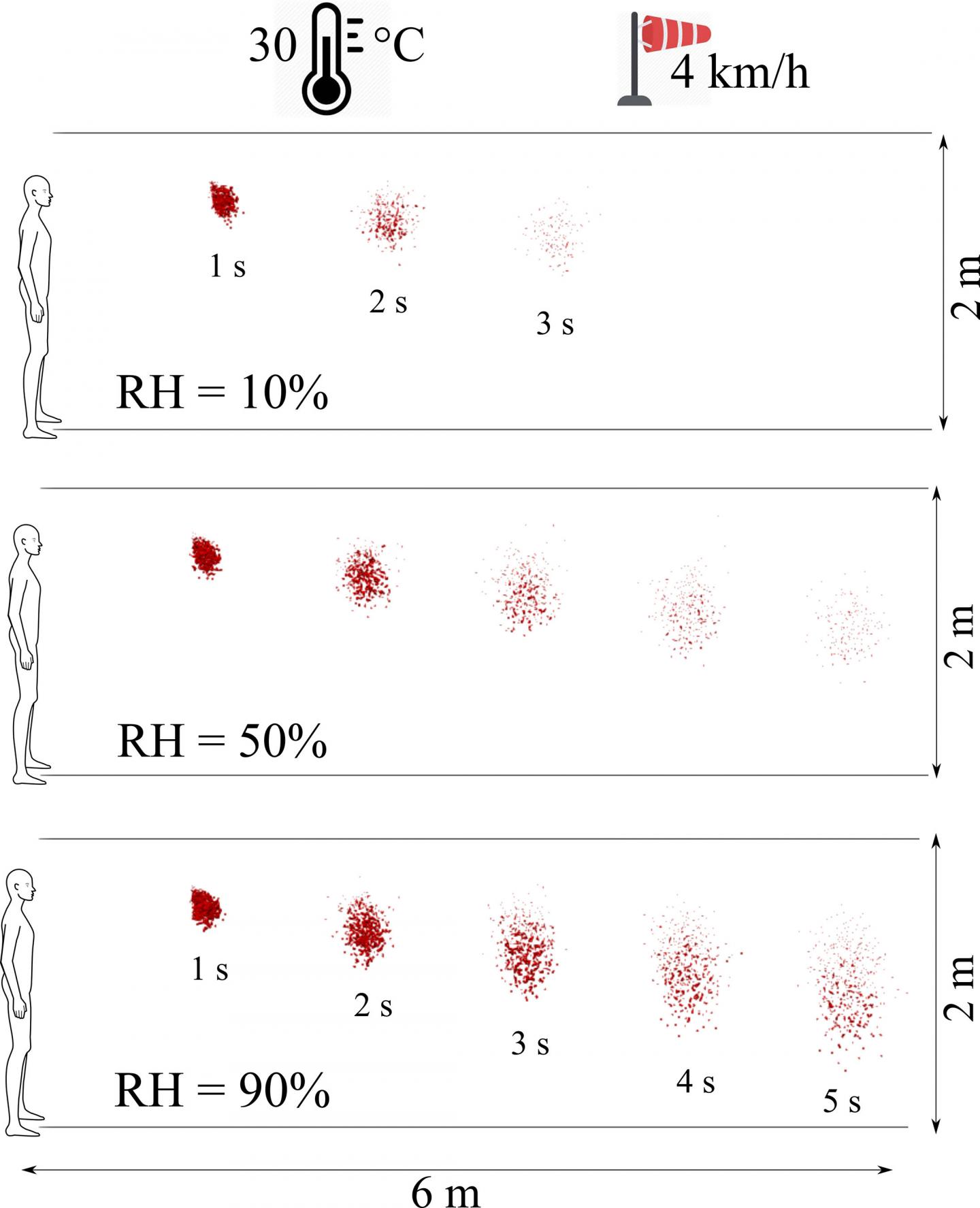Dr. Talib Dbouk and Professor Dimitris Drikakis speak to News-Medical about their research efforts during the COVID-19 pandemic, and how evaporation is essential for coronavirus transmission in the winter.
What provoked your research into the transmission of viruses, and in particular, that of the coronavirus?
As researchers, our mission is to investigate and better understand the flow physics and transmission dynamics of viruses.
What mainly provoked our research is our interest to contribute to stopping the rapid spread of the deadly coronavirus, which has been causing the death of hundreds of thousands of people around the globe unexpectedly and has had significant financial implications.
Image Credit: GEMINI PRO STUDIO/Shutterstock.com
Why are winter virus infections more common than those in the summer months?
We found from our research results that there exists a combination of factors affecting virus transmission. It is related to the wind speed, air temperature, and relative humidity.
During the winter season, especially in cold winter countries like North and Central Europe, North America, and Russia, people spend most of their time indoors. The indoor environment usually has a specific microclimate, e.g. heated to an average temperature between 23°C and 25 °C, and the relative humidity can reach up to 65% or more.
During the summer, people have more of a tendency to go outside, and there is no heating indoors, but air-conditioning leads to relatively low humidity values. During the summer, air temperature can go above 30 °C, and the relative humidity can decrease below 50% in some places.
Our research showed that the viability of coronavirus is higher at low air temperature values below or equal to 25°C, and at high relative humidity values greater than or equal to 65%. This explains clearly why winter virus infections are more common than those during the summer months.
Moreover, we also illustrated the role of wind speed (that is usually higher during winter months) contributes more to the virus transmission rate.
Winter
Image Credit: Marina Zezelina/Shutterstock.com
Why has research into the importance of airborne droplet transmission been scarce?
Indeed, we have conducted a comprehensive literature survey and surprisingly found that research focusing on the importance of airborne droplet transmission has been scarce. Several factors might explain this, mainly:
-
- Previously, researchers focused on more traditional biological aspects of the virus and gave secondary importance (or none at all) to factors such as the airborne transmission, fluid dynamics, and heat transfer.
-
- The fact that the last pandemic of COVID-19 was very deadly and is causing both deaths and financial losses has prompted researchers like us to investigate aspects of virus transmission that are not understood at all.
-
- In the past, the lack of advanced computational fluid dynamics methods and expensive computing hardware to perform complex fluid dynamics and heat transfer simulations also hindered progress in the area of simulation of fluid dynamics and heat transfer. There was significant progress in the above areas in the past decade or so. This now helps perform detailed simulation studies.
Can you describe how you carried out your research into coronavirus viability?
We developed an advanced CFD (Computational Fluid Dynamics) numerical platform that allows the prediction of coronavirus concentration variation in contaminated airborne saliva droplets (after being expelled into the air).
The computational models developed in the framework of this research allow the quantification of the coronavirus viability as a function of air temperature, relative humidity, and the surrounding wind speed or air circulation in indoor and outdoor environments.
What did you discover from your research?
We discovered that the viability of coronavirus depends on the combination of the air temperature, the wind speed, and the relative humidity.
How is the coronavirus transmitted by evaporation?
The coronavirus is transmitted through airborne contaminated saliva droplets that contain a specific concentration of virus particles. The virus particle carriers which are the saliva droplets, when expelled from an infected person, fly in the air.
While traveling in the air, they witness the evaporation process, which can be linked to the coronavirus viability.
Airbone Transmission
Image Credit: Aliaksandra Post/Shutterstock.com
How will your research help further our understanding of coronavirus transmission?
Our research through the newly developed CFD simulation platform allows future critical investigations such as to defining better social distancing safety distance and rules that should be dynamic, and not fixed.
The above depends on the indoor and outdoor conditions, e.g. related to the surrounding environment temperature, its relative humidity, and its air circulation rate amongst others.
Do you believe that factors such as wind speed and humidity should be considered when evaluating social distancing guidelines?
Of course, because the safety distance and rules significantly depend on the indoor and outdoor conditions (e.g. related to the surrounding environment temperature, its relative humidity, and its air circulation rate amongst others).
What can people do to protect themselves from increased virus survival and transmission rates in the upcoming winter months?
For people do to protect themselves from increased virus survival and transmission rates in the upcoming winter months, we advise:
a- To respect the social distance, at least 2 meters if no air circulation is present, and in case of air or wind speeds, this social distance should be up to 6 meters depending on the wind speed. We have published another detailed study on this subject: https://aip.scitation.org/doi/10.1063/5.0011960
b- Avoid conditions of high relative humidity, especially indoor
c- Avoid places of low temperature.
d- Avoid crowded places
e- Wear protective face masks, especially in situations where there is unavoidable close contact with other people. See our previous study on face masks: https://aip.scitation.org/doi/10.1063/5.0015044
f- Avoid forced air convection or forced air circulation in closed indoor places.
g- Apply natural ventilation and air circulation indoors
Social Distancing
Image Credit: Kzenon/Shutterstock.com
What are the next steps in your research?
Our next steps include investigation of other physical mechanisms and their interaction with virus transmission such as air pollution.
Where can readers find more information?
About Dr. Talib Dbouk
Dr. Talib Dbouk is a senior researcher at the Defence and Security Research Institute of the University of Nicosia, Cyprus. Before that, he held different academic and research positions in France as Associate Professor at
Mines-Telecom Institute, and Post-doc researcher at CEMEF Mines-ParisTech and the French Center of Atomic Energy (CEA)
.
He holds an HDR (in French: Habilitation à Diriger des Recherches) from the University of Polytechnique Hauts-de-France (Nov. 2019) and a Ph.D. degree in Physics from the University of Nice-Sophia Antipolis, France (Dec. 2011). His research is multidisciplinary in the domains of computational physics and engineering science and emerging technologies.
His research includes software development and advanced computational tools for topology and shape optimization, multidisciplinary design optimization, computational fluid dynamics (CFD) and heat transfer, and rheology of complex fluids, amongst others. He has received from the french Foam-U association an award in 2017 for the best Ph.D. thesis on a computational code developed within an open-source CFD platform.
His research work and impact are manifested through many published research articles in high impact-peer review journals. So far, he has supervised and graduated many Ph.D. and MSc students who now hold different positions in academia and industries around the world. He is a reviewer for many high impact scientific journals and an editorial member board of two.
During the last decade, he has been developing, coordinating, and leading several advanced R&D and innovative projects in collaboration with both national and international partners from both industry and academia. He has been developing highly advanced scientific computation codes for different multi-scale and multi-physics applications.
About Professor Dimitris Drikakis
Prof. Dimitris Drikakis is the Vice President for Global Partnerships and Executive Director, Research and Innovation at the University of Nicosia, Cyprus. He has a joint professor’s appointment in the School of Sciences and Engineering, and Medical School. Before that, he held academic and executive posts as Professor, Executive Dean (Strathclyde University), and Head of Aerospace Sciences and Engineering Physics Departments (Cranfield University) in the UK university sector for 24 years; he has also held senior academic/research posts in Germany and France.
His research is multidisciplinary and covers topics of engineering science and emerging technologies, including fluid mechanics, acoustics, materials, computational science, machine learning, computational intelligence, and nanotechnologies with applications to aerospace and defense, biomedical, and energy sectors. He has received the William Penney Fellowship Award by the UK’s Atomic Establishment in recognition of his contributions to multicomponent flows, and the Innovator of the Year Award (2014) by the UK’s Innovation Institute for a new generation carbon capture nanotechnology.
He has co-authored two books and has published 430 papers in journals and conference proceedings. He has graduated 45 Ph.D. students who now hold positions in academia and industries around the world. He has also been an Assoc. Editor in many scientific journals. He has also served on the Fluid Dynamics Technical Committee of the American Institute of Aeronautics and Astronautics; Board of Directors of the European Aeronautics Science Network; European Research Council (Engineering – Deputy Chair); UK’s Oil and Gas Technology Centre (OGTC), as a Chair of the academic panel.
Source: Evaporation is critical for coronavirus transmission in winter




